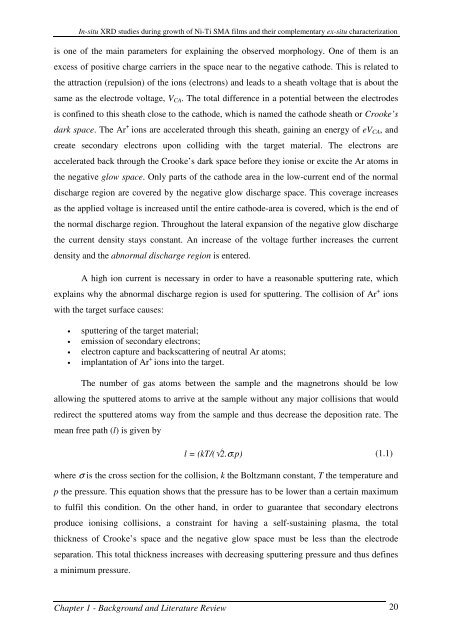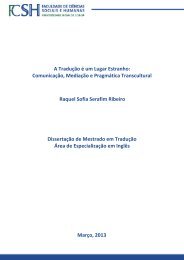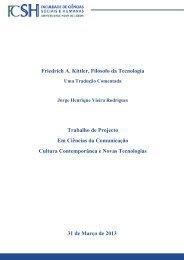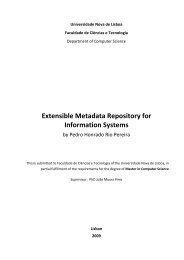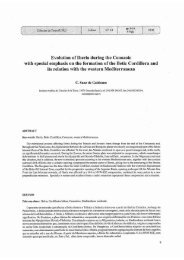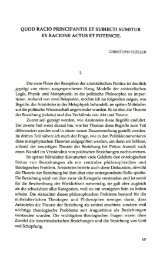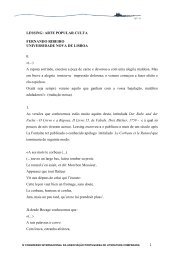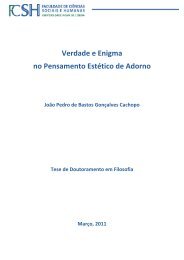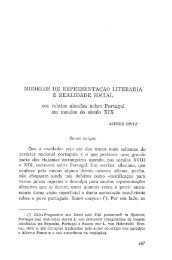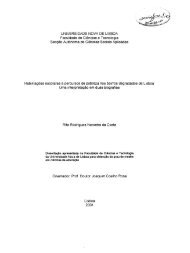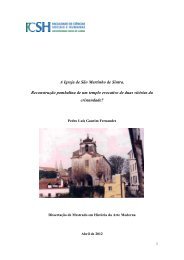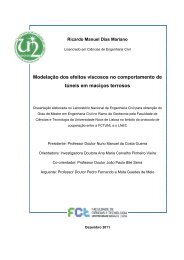PhD Thesis_RuiMSMartins.pdf - RUN UNL
PhD Thesis_RuiMSMartins.pdf - RUN UNL
PhD Thesis_RuiMSMartins.pdf - RUN UNL
Create successful ePaper yourself
Turn your PDF publications into a flip-book with our unique Google optimized e-Paper software.
In-situ XRD studies during growth of Ni-Ti SMA films and their complementary ex-situ characterization<br />
is one of the main parameters for explaining the observed morphology. One of them is an<br />
excess of positive charge carriers in the space near to the negative cathode. This is related to<br />
the attraction (repulsion) of the ions (electrons) and leads to a sheath voltage that is about the<br />
same as the electrode voltage, V CA . The total difference in a potential between the electrodes<br />
is confined to this sheath close to the cathode, which is named the cathode sheath or Crooke’s<br />
dark space. The Ar + ions are accelerated through this sheath, gaining an energy of eV CA , and<br />
create secondary electrons upon colliding with the target material. The electrons are<br />
accelerated back through the Crooke’s dark space before they ionise or excite the Ar atoms in<br />
the negative glow space. Only parts of the cathode area in the low-current end of the normal<br />
discharge region are covered by the negative glow discharge space. This coverage increases<br />
as the applied voltage is increased until the entire cathode-area is covered, which is the end of<br />
the normal discharge region. Throughout the lateral expansion of the negative glow discharge<br />
the current density stays constant. An increase of the voltage further increases the current<br />
density and the abnormal discharge region is entered.<br />
A high ion current is necessary in order to have a reasonable sputtering rate, which<br />
explains why the abnormal discharge region is used for sputtering. The collision of Ar + ions<br />
with the target surface causes:<br />
• sputtering of the target material;<br />
• emission of secondary electrons;<br />
• electron capture and backscattering of neutral Ar atoms;<br />
• implantation of Ar + ions into the target.<br />
The number of gas atoms between the sample and the magnetrons should be low<br />
allowing the sputtered atoms to arrive at the sample without any major collisions that would<br />
redirect the sputtered atoms way from the sample and thus decrease the deposition rate. The<br />
mean free path (l) is given by<br />
l = (kT/(√2.σ.p) (1.1)<br />
where σ is the cross section for the collision, k the Boltzmann constant, T the temperature and<br />
p the pressure. This equation shows that the pressure has to be lower than a certain maximum<br />
to fulfil this condition. On the other hand, in order to guarantee that secondary electrons<br />
produce ionising collisions, a constraint for having a self-sustaining plasma, the total<br />
thickness of Crooke’s space and the negative glow space must be less than the electrode<br />
separation. This total thickness increases with decreasing sputtering pressure and thus defines<br />
a minimum pressure.<br />
Chapter 1 - Background and Literature Review 20


